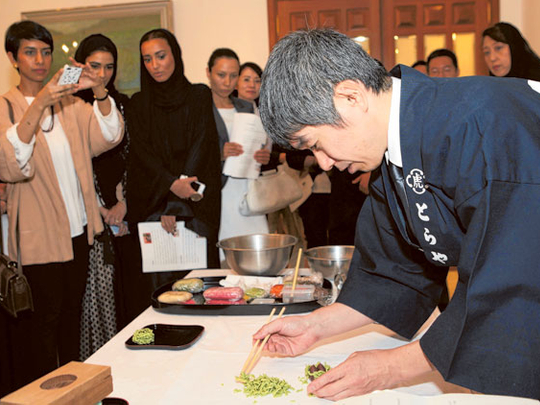
Dubai: When you mention Japanese food, the first thing that most probably comes to mind is sushi.
But unknown to many, there is one section of the Japanese cuisine — traditional confections called wagashi — that seldom gets the same attention yet is equally intriguing to the palate, say foodies.
Wagashi stands for Japanese sweets, culinary treasures that have become an art form through the years and dates date back to the seventh century when Japan first traded with China.
‘Wa’ means Japan while ‘gashi’ pertains to confections. But unlike in other countries where sweets or desserts are served typically after a meal, the Japanese have a different take on sweets.
“In Japan, we don’t eat dessert after we eat. This Japanese confectionery we call wagashi is eaten at 3pm as a snack; the other kind of wagashi is for tea ceremony,” Futoshi Yoshida, master patisserie chef at Toraya, Paris, told Gulf News during a wagashi-making demonstration in Dubai.
Toraya has been in existence for 500 years making it one of the oldest confectionery makers in Japan. It has been the official maker of wagashis for the Japanese Imperial Family for the past four centuries.
Feast of the senses
Inherent to traditional Japanese food is presentation.
But beyond wagashi’s colourful appearance lies the distinctive fusion of flavours and aroma from natural ingredients such as ‘azuki’ (red and white) beans, grains, and special sugars of Japan.
Its texture must be soft, moist, or crisp to signify freshness.
Toraya has 3,000 kinds of wagashi — be it flowers, fruits, or a symbol of Mt. Fuji.
Better known to reflect the subtle transition of nature, wagashis are made specific to the changing of the season.
“Japan is located in a temperate zone in terms of climate. Therefore, we have distinct four seasons and in Japanese culture it is always emphasized that each season has to be appreciated fully,” Japanese Consul-General to the UAE Matsunaga Daisuke told Gulf News.
“In order to emphasize the seasonality, the Japanese confectionery also is very very sensitive to Japanese seasonality,” he added.
Besides the seasons, certain wagashis are also associated with calendar events like the New Year and other Japanese festivals.
Perfect timing
Most wagashis are intricately made by hand, using traditional techniques passed on from one generation to the next. To make it, timing is crucial. Hence, to become a full-fledged wagashi artisan, one needs to learn and practise the art for about 10 years.
For Yoshida, who has perfected the craft for over 20 years, the secret lies from within.
“The secret of delicious wagashi is that I put my heart in it, and then also passion for making Japanese confectionery,” he said.
While there is no wagashi shop in the UAE, Daisuke hopes that Yoshida’s demonstration in Dubai will eventually lead to one.
Trying out another part of the Japanese cuisine, he said, will actually give your taste buds a whole new experience.
“Each country has its own sweets, its own tradition. As we taste something different, I think we enjoy life even better. So if we are open to other cultures, not only in terms of literature, movies, artwork, but even in the field of confectionery, sweets, we can be more open to a variety of things from other countries,” Daisuke said.












